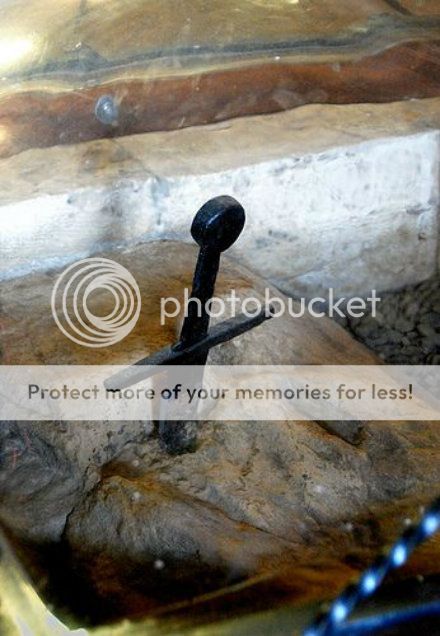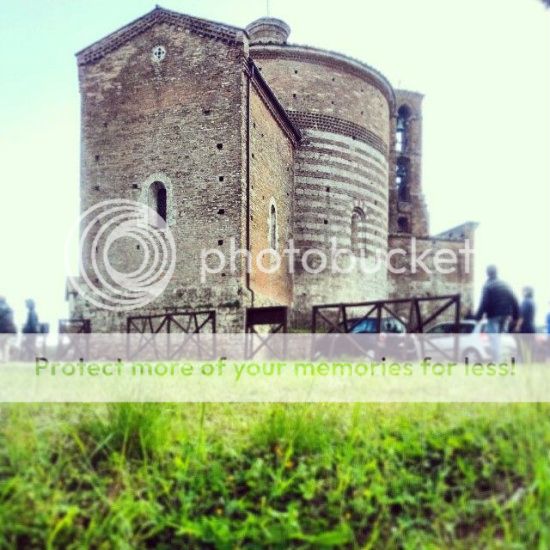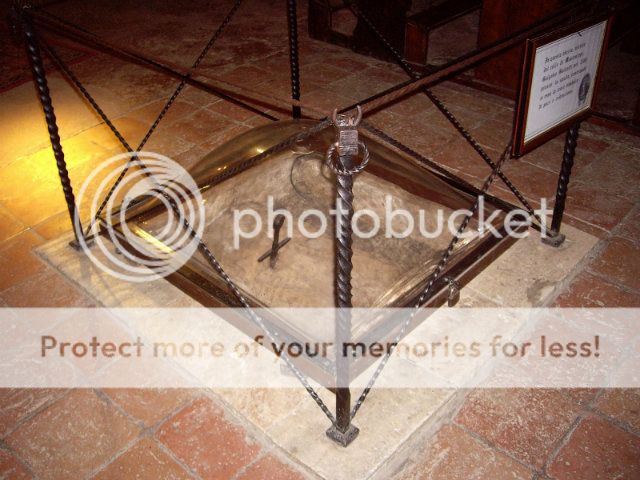-
*Astrella.
User deleted
King Arthur in Tuscany? San Galgano and the sword in the stone - Italy

Did King Arthur Come From Italy?
A mysterious "sword in the stone" said to have been thrust into a rock near Siena by a medieval knight proves that the legend of King Arthur, Excalibur and the Holy Grail originated in Tuscany, not Cornwall or Brittany, an Italian scholar claims.
The sword, of which only the hilt and an inch or two of blade is visible, is preserved at the Gothic abbey of San Galgano at Montesiepi, about 19 miles (30 km) southwest of Siena. The Cistercian abbey, now ruined, was built to honor St Galgano, a 12th-century Tuscan nobleman named Galgano Guidotti who renounced a life of "arrogance, lust and violence" to become a hermit after seeing a vision of the Archangel Michael.
To symbolize his rejection of war, he supposedly plunged his sword into the rock, which miraculously "parted like butter", leaving only the hilt exposed to form the shape of the Cross.
It has been assumed that the Tuscan "sword in the stone" is a fake, made to echo the Celtic legend of King Arthur as told by Geoffrey of Monmouth and Chretien de Troyes and by Thomas Malory in his celebrated 15th-century Le Morte D'Arthur.
But a study by the medieval historian Mario Moiraghi suggests that the story of St Galgano and his sword was the origin of the myth of King Arthur and the Knights of the Round Table, embellished by medieval troubadours as it spread from Tuscany.
In The Enigma of St Galgano, Moiraghi -noted for his work on the Templars - claims that writers such as De Troyes were inspired by the tale of Galgano and not the other way round. "The dates support this," he said. "Galgano died in 1181, and the story of his miraculous act swiftly became widely known when he was canonized."
De Troyes wrote Perceval in 1190, and Wolfram von Eschenbach wrote the German version of the Holy Grail myth between 1210 and 1220, also focusing on Perceval (or Parsifal), the knight of humble origin who finds the Grail. Richard Wagner based his text for Parsifal, his last stage work premiered in 1882, on Von Eschenbach.
Moiraghi said that the testimony of Dionisa, St Galgano's mother, to the panel of cardinals considering his canonization in 1190 contained "all the essential elements of the Round Table myth": a knight who overcomes all obstacles to reach his ideal; his search for a Holy Grail (in Galgano's case an indecipherable text he saw in a vision rather than the cup from the Last Supper); and the "central role of the sword". Tales of chivalry brought back from Persia by merchants became popular in Tuscany at about the same time.
Moiraghi said that the Arthurian "round table" may have been inspired by the shape of the chapel built over the sword in the stone at Montesiepi (the Rotunda). Even the name "Galgano" may have been corrupted into "Galvano" by later writers, giving birth to the figure of Gavin or Gawain, Arthur's nephew and at one stage his ambassador to Rome.
The theory that the legend of St Galgano predates rather than copies the story of Arthur is supported by tests on the sword at the Tuscan abbey. Scientists say that it is made of a metal and style "compatible with the era of St Galgano". Luigi Garlaschelli, a research scientist at the University of Pavia who helped to conduct the tests, said that there appeared to be a cavity beneath the rock. The church authorities had not yet given permission for an excavation to show whether this contained further evidence, such as the saint's remains.
It's towards the end of 1100 A.D.. The story that we are about to tell centers around a round chapel, a knight and a sword in the stone. But instead of the mythical kingdom of Camelot, we are in Montesiepi, in the heart of Tuscany.
The sword in the stone is not Excalibur and the knight is not King Arthur.
Its mystery is kept in a book that has been sealed for more than 800 years. A book that could reveal many of the secrets that surround the se arch for the Holy Grail.
Galgano Guidotti was born in Chiusdino in 1148, the only son of Guido and Dionisia. From his youth, Galgano leads rather a dissolute life, until, at the age of 32, the Archangel Gabriel appears to him in a dream and tells him to follow him. In the dream, Galgano receives an order from the 12 apostles to build a round chapel at Montesiepi and to retire there to live. His mother and friends try to convince him to desist, but his horse takes fright and takes him to Montesiepi.
At Montesiepi, Galgano thrusts the Sword forcefully into the ground to make a cross and miraculously the Sword gets stuck in the stone. This situation causes quite a sensation and Montesiepi becomes filled with many pilgrims asking Galgano to perform Miracles. Before his canonization in 1185, 19 such miracles occur.
In 1190 a French write wrote a lengthy text telling the story of a king and other riders who leave in search of a mysterious object, which is the Holy Grail. A few years later, another German writer tells a similar story and wrote the Parsifal. Much of what these writers tell in their works have strange similarities with a sword in the stone that is found in this church.
There are many coincidences, and when analyzed in detail, they are even more impressive because the life of Galgano of Montesiepi, as certified in the beatification, correspondes almost entirely to the life of Parsifal. The Grail is the chalice of the Last Supper, or the container that collected the blood of Christ and the Round Chapel at Montesiepi, reminiscent of an upside down cup, would be just such a representation.
Many have indicated the place as a possible hiding place of the Holy Grail. Testimonies speak of a secret underground cavity which is accessed by moving a single stone in the floor of the anteroom. No one has yet succeeded in finding the secret passage, but in addition, the Grail and the Sword in the Stone point to a connection that may exist between Galgano and King Arthur, that they could perhaps be one in the same person?
What emerges quite clearly in the novels of the round table, is the fact that, at the beginning, this gentleman, Galvano, whose name resembles very closely Galgano, plays an important role in the tale of the round table, as he is known as the "first Knight". Then there is a gradual phenomenon of the name fading away over the years, due to the evolution of the tales of the round table, and the name of Galvano becomes less important, as if the novels about the round table no longer have need of this Tuscan knight.
What is certain, is that in the representations of the Knights of the Round Table, the Sword Excalibur often appears in the hands of Galvano and the mysteries of Montesiepi do not end here. When Galgano dies, the round chapel is built, which according to many scholars constitues a real book in stone. Whomever is able to i nterpret it, will then know the secret of the Holy Grail. Galgano dies in 1181 and in record time the Church proclaims him a Saint. In fact, only four years later, Pope Lucius III acts with the swift canonization process of the Knight.
Yet San Galgano was not a very venerated Saint during those years, in as much as, his message was inspired as an act of peace. Planting a sword in the stone to pray, was the opposite of what the church needed during the bellicose era of the Crusades. In the literature of that era it is possible that San Galgano becomes King Arthur and that his legendary sword was used instead to defy the infidels.
A few years ago, a confirmation: the University of Pavia certified that the sword is actually from the 12th century. The Enigma of San Galgano, however, is likely to remain a mystery. The truth lies indeed impenetrable among the records regarding his canonization, kept in custody in the safe of the Consistory of Siena. A truth sealed for eternity? What seems certain is that the myth of King Arthur has completely stolen the true story of the Tuscan Saint and, perhaps, the real sword in the stone is here, in Italy.
Source: www.sangalgano.org/ENG/abbeyofsangalgano.htm.
King Arthur in Tuscany? San Galgano and the sword in the stone - Italy14 Agosto 2014 |


